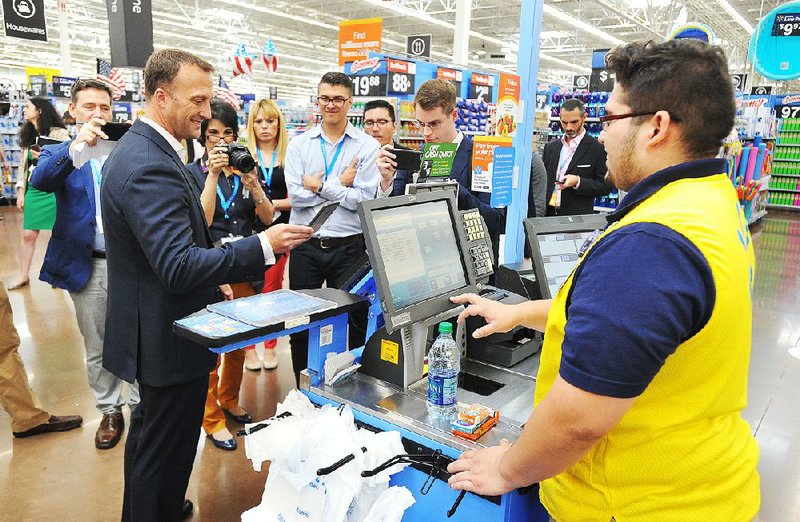Wal-Mart Stores Inc. Chief Executive Officer Doug McMillon was adamant the retailer doesn't have a "price-perception problem" during a question-and-answer session with investors earlier this month.
Instead, McMillon admitted there have been other factors at play as Wal-Mart works to maintain its reputation as the low-prices leader in a changing retail landscape.
"We were too stagnant for a while," McMillon said. "We weren't playing offense with it. We just kind of got to a steady state and we left it. We thought, 'That was good, let's move on to something else.'"
Wal-Mart is putting pricing back in the spotlight, though, as it navigates an environment in which analysts say competitors like Amazon.com and other discounters have dulled the retailer's edge as the destination for low prices. The company revealed during its first-quarter earnings call last month that it began adjusting prices in the U.S. earlier than anticipated, and the topic remained an emphasis throughout the company's shareholders week.
It was reinforced last week as well, when Wal-Mart U.S. Chief Merchandising Officer Steve Bratspies participated in the 2016 Emerging Trends in Retailing Conference in Rogers. He told roughly 300 attendees -- many of whom were Wal-Mart suppliers -- that the retailer was founded on the notion of delivering an everyday low price to customers and that those values are being reinforced.
"We're more committed than ever to deliver on this promise, and we're doing it on our own terms," Bratspies said, noting that research indicates price remains a customer's top concern.
The everyday low-price model became one of the key strategies of Wal-Mart's growth into the world's largest retailer under founder Sam Walton. Chief Financial Officer Brett Biggs told investors during the Deutsche Bank Access Global Consumer Conference in Paris on Wednesday that the company did not stray from those principles, saying there is no "on-off switch." But Wal-Mart did step back to try other tactics as the company tried to position itself for long-term growth.
Growth strategies
The retailer has poured $2.7 billion over two years into wage increases and other employee-specific initiatives in an attempt to improve morale, which Wal-Mart said will pay off by improving the customer experience and driving sales.Wal-Mart also has spent billions on e-commerce and technological advances to improve efficiency and provide customers with a seamless shopping experience, giving them opportunities to shop for any product in any way and at any time.
The investments have dented Wal-Mart's profit, but the retailer believes the efforts are starting to pay off. So Wal-Mart moved forward with lowering prices in the first quarter of the fiscal year.
Most of Wal-Mart's specific strategies for lowering prices haven't been revealed, but McMillon cautioned investors not to "overreact and think something dramatically different is going to happen quickly." He said the retailer has a plan to reduce the price of items in different sections of stores.
"A Supercenter can be like a boat," McMillon said. "If you don't blend the mix and have price leadership all over the [store], and you're just investing in food and consumables, you tilt the boat over too much. So we want to be smart about how we manage the entire box and let customers save money in all the departments."
Wal-Mart also will try to reinforce its reputation through marketing and advertising efforts, bringing Smiley -- the company's yellow, smiling logo -- back to the forefront. The logo became synonymous with slashing prices but had been behind the scenes for much of the past decade. Wal-Mart is beginning to use the logo in advertisements, and Bratspies said the retailer will get "really aggressive" to show low prices in stores.
Bratspies said there are other structural initiatives taking place as well. Wal-Mart recently announced a partnership with McKesson Corp., and the companies will work to buy generic drugs at lower prices. The retailer announced plans earlier this year to build its first milk-processing plant in Fort Wayne, Ind., in hopes of reducing costs. Wal-Mart also continues to expand its global sourcing with offices around the world, which allows the retailer to get closer to the source of products.
Wal-Mart is also expanding its offerings of private-label products, another initiative that allows the retailer to better control costs. Wal-Mart recently unveiled its culinary and innovation center at its Bentonville headquarters, where products are tested and prepared to land on Wal-Mart's shelves.
"Private label can be a higher-margin avenue for a retailer," said Dwight Hill, a retail consultant and partner with Chicago-based McMillan Doolittle. "You can control the distribution. You can control the supply chain in a lot better way and you sort of become a little more vertically integrated as it were. So it's typically higher profit, which Wal-Mart may choose to give straight back to the customer."
Greg Foran, the head of Wal-Mart's U.S. stores, said the retailer has big enough stores that it doesn't have to be a "one-trick pony" and rely solely on private brands. Private brands help Wal-Mart offer a diverse selection of products, but the retailer said it remains serious about national brands as well because they're important to helping Wal-Mart establish itself as a low-price retailer.
"It's pretty hard doing everyday low price on products that are not necessarily comparable with anyone else in the marketplace," Foran said. "I like the fact we sell brands. I like the fact that we are going to do private label. We're going to sensibly manage that mix as we do with fresh foods and try and create an offer that is not only great for the customer but delivers a good financial return."
Supplier cooperation
The effort to lower prices can create challenges for suppliers, which are often asked by the retailer to find ways to cut costs. Complying with Wal-Mart's suggestions is important to suppliers because of the retailer's size and scale, often representing a substantial chunk of the company's sales.
Darrell Rosen, who spent 30 years with Procter & Gamble and is now president and chief operating officer of Fayetteville-based Optimus Training and Development, said Wal-Mart makes periodic reminders to suppliers to keep costs as low as possible. Rosen said maintaining a pricing edge and keeping low prices "alive and well" is critical for Wal-Mart, but must be challenging in the current landscape because of competitors like Amazon.com.
"The ability for a shopper or consumer to acquire a product -- there's lots of options," Rosen said. "All of that competitive nature creates a whole new environment to compete in. If price and providing everyday low price is core to your strategy, I would think that's going to put more pressure on Wal-Mart to reinvigorate that discipline of [everyday low prices] from inside their company as well as that supplier base."
Bob Williams, senior vice president and managing director of Simmons First Investment Group Inc. in Little Rock, said it's much more difficult to find ways to squeeze out efficiencies and lower prices.
"There's no question the internet and the marketing has eroded the economies of scale," Williams said. "It is so much cheaper to operate a highly efficient warehouse distribution center than a traditional retail, bricks-and-mortar store. It really starts to squeeze the margins."
But Wal-Mart is optimistic its new pricing will be successful, saying it believes its low-price plan will continue to drive traffic into stores and grow sales for both the retailer and its suppliers. The company is targeting revenue growth between $45 billion and $60 billion over the next three years.
McMillon said he is certain competitors will react to what Wal-Mart does with pricing, but added "that's what the marketplace is intended to do." Foran said Wal-Mart would much rather lead the way.
"I like playing offense much better than I like playing defense," Foran added. "I like when Steve [Bratspies] and his team are out there actually leading on prices, rather than reacting to someone's prices, [and] setting new benchmarks. It puts a spring in our step."
SundayMonday Business on 06/19/2016

